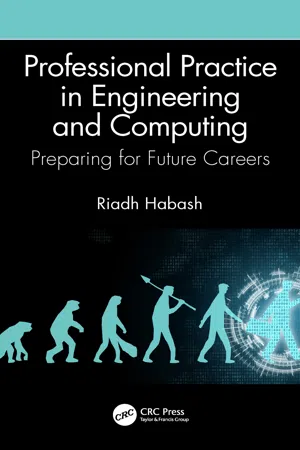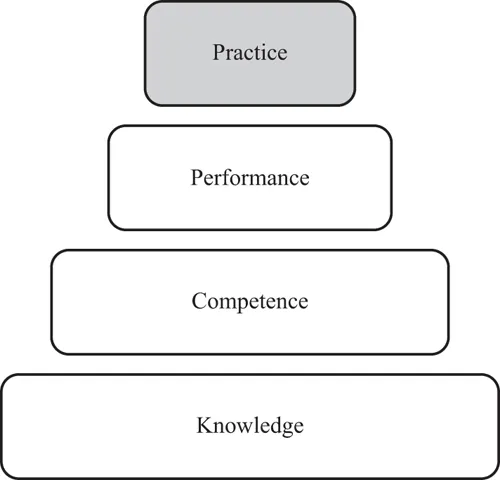![]()
module one
The composite professional
1.1 Knowledge and understanding
Having successfully completed this module, you should be able to demonstrate knowledge and understanding of:
• The impact of engineering, computing, and project management in developing the futuristic knowledge practice to facilitate innovative and sustainable solutions to society’s greatest challenges
• Historical evolvement and development of engineering practice as one of the oldest professions which led to the rise of the Industrial Revolution
• Advances in computing technologies that generated a web of dynamic virtual networks that allow people worldwide to communicate and share information
• Management evolvement through the nineteenth and twentieth centuries in response to waves of innovation in business and society and its overall role on harmonizing planning, organizing, implementing, and controlling future work, workforce, and the workplace
• The notion of a “composite professional” who can integrate knowledge, competence, expertise, business know-how, communication skills, leadership, and entrepreneurial talents
• Instruction that prepares students for the route of professional and career development with emphasis on lateral thinking as well as on real-world problem-solving methodologies
1.2 Professional identity and practice
From Wi-Fi to space travel, engineers, project managers, and information technology professionals develop innovative and sustainable solutions to society’s greatest problems.
Futurist Michio Kaku
Future development as perceived in the quotation above is not just about technology but is a synergy of broad knowledge platforms of engineering ingenuity, information technology (IT), and management (Figure 1.1). Ingenuity means the process of applying ideas to solve real-life problems to meet new generational challenges. To increase synergy, there is a need to define and establish different educational and training platforms to help realization of the knowledge practice platforms.
Figure 1.1 Futuristic knowledge platforms.
The terms “professional”, “professional identity”, and “professionalism” are cited interchangeably in education. The American philosopher Mortimer J. Adler defined a professional as “a man or woman who does skilled work to achieve a useful social goal. In other words, the essential characteristic of a profession is the dedication of its members to the service they perform” (Manning and DeBakey 2003). Professional identity is part of a complex, multifaceted, continuous process of personal identity development. As part of this process, students simultaneously develop several identities, such as religious believer, partner, citizen, engineer, and others (Beam et al. 2009). Identities are the meaning that individuals hold for themselves, what it means to be who they are. These identities have bases in being members of groups (social identity), having certain roles (role identities), or being the unique biological entities that they are (personal identities) (Burke 2004). Professionalism will be discussed in detail in Module 2.
In the context of practice, knowledge represents a broad sense of theoretical and practical “knowledge” and “skills”. Professional knowledge that accumulates through practice is organized and codified to facilitate importing concepts and ideas from other disciplines in the expansion of the knowledge base (Nilsson 2007).
Professionals learn and grow in various ways, and only part of their professional growth is intentionally enhanced by professional development interventions, programs, and activities. According to Cochran-Smith and Lytle (2001), knowledge in the process of practice development is classified into three types as shown in Figure 1.2. First, knowledge-for-practice, which represents formal knowledge for professionals to improve practice through education and lifelong training and learning. Second, knowledge-in-practice, which means knowledge embedded in the practice process. Third, knowledge-of-practice, which grows through reflection on the practice by using the process of inquiry.
Figure 1.2 Knowledge in the process of practice development.
Instead, competence is understood as a broader concept than knowledge but also an affective component, including attitudes, values, behaviors, and motives, as well as personal traits, such as self-efficacy and self-confidence, and socio-communicative skills (Nilsson 2007). Competence or “know-how” is the ability, not yet put into practice, to do something as a result of knowledge in the presence of experience and judgment. It is the strategy an individual would apply in practice if an opportunity exists. It is divided into a formal aspect (formal merits and credentials) and an actual aspect (an individual’s capacity to appropriately manage a situation or complete a task).
| | |
On the other hand, performance is based on competence but is adapted by system factors and other circumstances. It is the implementation of learned strategies. Professional performance may be influenced by knowledge, competence, or by other factors external to the individual, including the system within which one practices (for example, incentives, resources, expectations, or demands). In brief, performance is competence implemented, or applied in actual practice: “show-how”.
The last leg of the journey is placing competence and performance into practice. This represents what professionals actually “do” during day-to-day practice. Having an impact on clients or society is often the result of more than just a single practitioner’s performance. Figure 1.3 shows a modified version of George E. Miller’s (1990) model. The different layers in Miller’s model represent a developmental sequence of stages. All levels are needed and have their own important impact on professional practice.
Figure 1.3 Developmental stages toward professional practice.
1.3 Engineering practice
Engineering is not only the study of 45 subjects but it is moral studies of intellectual life.
Prakhar Srivastav
Engineering is one of the oldest professions, along with medicine and law. However, it differs from the other professions in that doctors and lawyers generally provide their services to specific individuals or corporations. Engineering is a profoundly creative, social activity; it tends to design and build things under constraint, as well as providing services. An engineer’s responsibility is more often to society than to specific people (Habash 2017).
1.3.1 Engineering defined
The word “engineer” has its root in the Latin word “ingeniator”, which means ingenious, to devise, in the sense of construct, or craftsmanship. Several other words are related to ingeniator, including ingenuity (Johnston et al. 2000). The term “engineer” was used in the 1300s for a person who operated a military engine or machine such as a catapult or, later, cannon. The word “engine”, in turn, is derived from the Latin “ingenium” for ingenuity or cleverness and invention. The terms “art” and “technical” are important because engineering arranges elements in a way that may or may not appeal to human senses and emotions, and relates also to the Greek “technikos”, which involves art, craft, skill, and practical knowledge and language (UNESCO 2010).
While the objective of science is to understand nature, engineering’s objective is to build useful things using science. Engineers must not only build things, they must also do so within budgetary, schedule, resource, regulatory, and operational constraints (Coallier 2007). Practically, engineering is problem identification, formulation, and solving. It is concerned with the transformation of knowledge to value, by establishing the knowledge in some physical and functional form. At its domain, engine...



